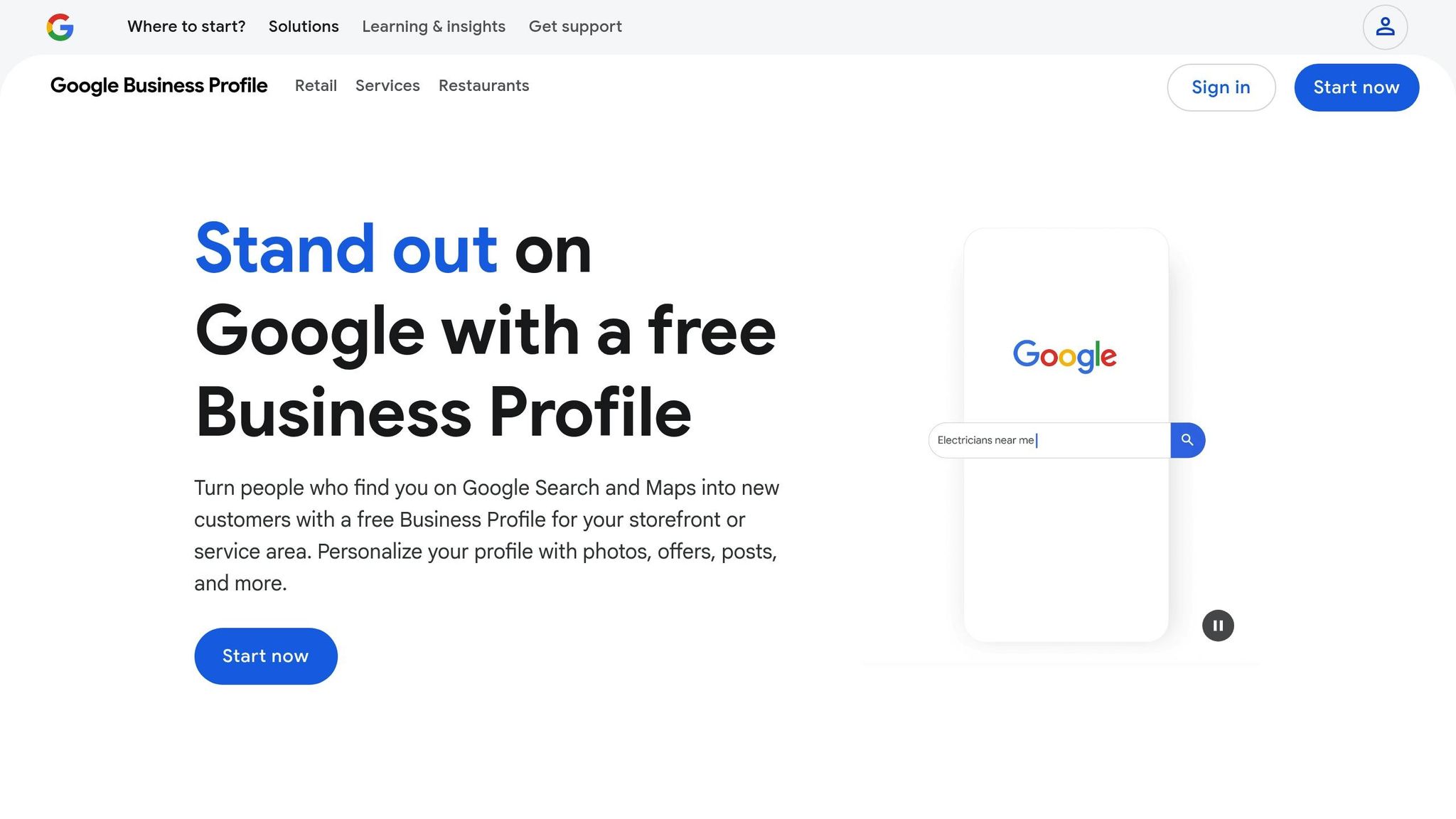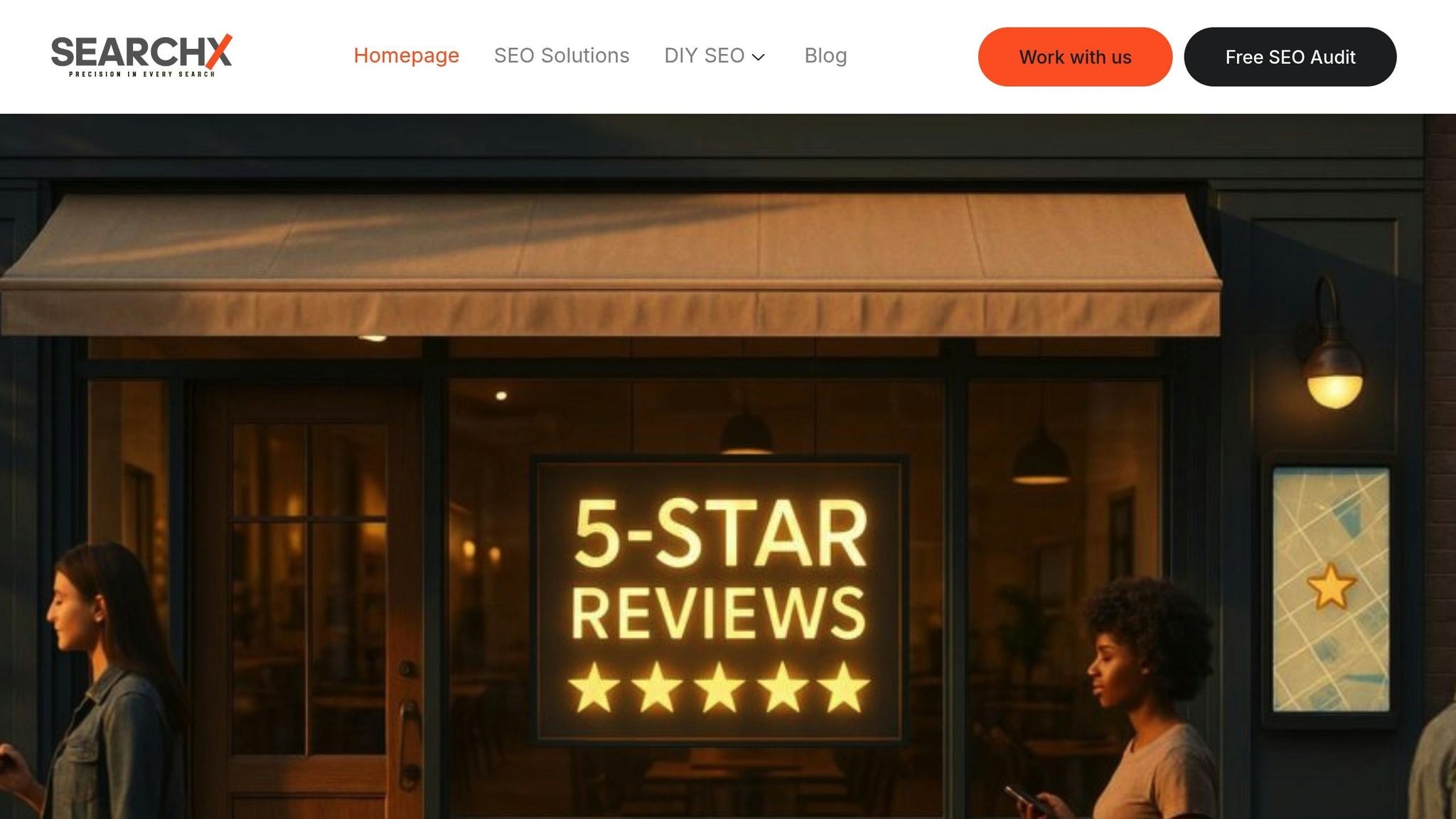Want to stand out in Austin’s competitive real estate market? SEO is your answer.
With over 90% of homebuyers starting their search online, having a strong digital presence is no longer optional. For Austin real estate agents, SEO isn’t just about visibility – it’s about connecting with motivated buyers and sellers in a city known for its booming housing market.
Here’s how SEO can help:
- Targeted Keywords: Focus on terms like “homes for sale in Zilker” or “best Austin real estate agent” to reach users with clear intent.
- Local Optimization: Use tools like Google Business Profile to dominate local searches and attract leads directly in your service areas.
- Content Strategy: Create neighborhood guides, market reports, and lifestyle-focused content to engage and inform potential clients.
- Technical SEO: Ensure fast-loading, mobile-friendly pages with optimized titles, meta descriptions, and schema markup for better rankings.
- Tracking Success: Monitor metrics like local keyword rankings, organic traffic, and conversion rates to measure ROI.
Whether you’re a new agent or an experienced pro, SEO can help you generate leads without relying solely on paid ads or third-party platforms. Start with local keyword research, optimize your website, and build trust through high-quality content. The sooner you invest in these strategies, the better positioned you’ll be to thrive in Austin’s growing real estate market.
How Realtors Can Maintain Their Google Business Profile to Rank on Google

Local Keyword Research for Austin Real Estate
In Austin’s competitive real estate market, finding the right keywords can make or break your online visibility. The difference between landing on page one versus page ten often boils down to targeting the specific terms your potential clients are searching for. Effective keyword research connects you directly with buyers and sellers looking for opportunities in Austin’s distinct neighborhoods and market segments.
Finding High-Intent Keywords
High-intent keywords reveal when someone is ready to take action – whether buying, selling, or exploring their options. In Austin’s real estate scene, these keywords fall into three main categories: transactional, commercial, and local informational.
- Transactional keywords reflect immediate intent, such as "Austin homes for sale", "sell my house fast Austin", or "Austin real estate agent near me." These often include action verbs like "buy", "sell", or "find", signaling readiness to move forward.
- Commercial keywords show someone is comparing options or researching services. Phrases like "best Austin neighborhoods for families", "Austin home prices 2025", or "top real estate agents in South Austin" suggest they’re narrowing down their choices.
- Local informational keywords blend location with specific needs. Examples include "Austin school district home values", "downtown Austin condos", or "Austin first-time homebuyer programs." These searchers are gathering details about particular aspects of the market.
Balancing search volume with competition is critical. High-volume keywords like "Austin real estate" face stiff competition from major platforms, while more specific phrases like "Mueller neighborhood Austin homes" or "East Austin investment properties" may have lower volume but offer better conversion rates.
Long-tail keywords – those detailed, specific phrases – are often hidden gems. For instance, "Luxury homes for sale in Westlake Austin" targets a niche audience with clear intent, making it easier to convert searches into leads.
Using Tools to Find Niche Opportunities
Uncovering niche keywords requires the right tools and strategies. Platforms like SearchX Keyword Research Service specialize in identifying location-specific opportunities that larger competitors might overlook, which is especially valuable in Austin’s diverse market.
Here’s how to get started:
- Analyze competitors: Explore the websites of successful Austin agents to see which neighborhood and service pages rank well. These can reveal proven keyword opportunities.
- Leverage Google autocomplete: Typing "Austin homes" into Google shows variations like "Austin homes under 300k" or "Austin homes with pools", giving insight into real searches.
- Explore "People also ask": Searching for "buying a home in Austin" might surface related questions like "What is the average home price in Austin?" or "Which Austin neighborhoods are up and coming?" Each question represents a chance to create targeted content.
- Use local search modifiers: Adding specifics like zip codes, neighborhood names, or terms like "near me" transforms generic keywords into more targeted ones. For example, "Real estate agent 78704" pinpoints South Austin, while "homes for sale near UT campus" appeals to the university crowd.
- Monitor seasonal trends: Austin’s market activity shifts with the seasons. Summer often sees a spike in family-oriented searches due to school schedules, while winter might bring more interest in investment properties. Anticipating these trends allows you to prepare content in advance.
Austin Real Estate Keyword Examples
Austin’s rapid growth and unique neighborhoods create plenty of keyword opportunities. Here are some examples tailored to the city’s market:
- Neighborhood-specific keywords: Austin residents often identify strongly with their neighborhoods, making terms like "Zilker homes for sale", "Mueller new construction", "Clarksville historic properties", and "Domain luxury condos" particularly effective.
- Lifestyle-based keywords: Austin’s culture and demographics open up phrases like "Austin music venue walkable homes", "dog-friendly neighborhoods Austin", or "live music district condos."
- Investment-focused keywords: With a strong rental market, terms like "Austin Airbnb investment properties", "UT campus rental properties", and "SXSW rental income properties" attract investors.
- Price-point keywords: Appeal to various market segments with phrases like "Austin starter homes under 400k", "luxury estates Lake Travis", or "affordable Austin condos."
- Development and growth keywords: Capture the city’s expansion with keywords like "Austin new construction communities", "Cedar Park master planned developments", and "downtown Austin high-rise living."
- Commuter-focused keywords: Address Austin’s traffic concerns with terms like "Austin homes near tech corridor", "properties close to Apple campus", or "Austin suburbs good commute."
The best strategy combines these keyword types into cohesive content. For example, a "Guide to Buying in East Austin" could naturally incorporate multiple related terms, offering real value while targeting dozens of keywords.
Finally, remember that keyword research isn’t a one-and-done task. Austin is a city in flux, with new developments and shifting neighborhood dynamics. Regularly revisiting your keyword strategy ensures your content stays relevant to how people are searching for Austin real estate.
Google Business Profile and Local Listings Setup
Your Google Business Profile acts as your digital storefront in Austin’s highly competitive real estate scene. When someone searches for "real estate agent near me" or "homes for sale in Zilker", a well-prepared profile can be the deciding factor between gaining a new client or losing them to another agent. Local listings also play a key role by ensuring your information is consistent across platforms, boosting your visibility with search engines. Let’s dive into how to set up and maintain your Google Business Profile and local listings to stand out online.
Setting Up Your Google Business Profile
Creating an effective Google Business Profile requires attention to detail, especially when targeting Austin home buyers. Start by claiming your profile at business.google.com and choosing "Real Estate Agent" as your primary category. This selection helps Google match your profile with relevant searches.
Fill out every section accurately. Your business name should match exactly what appears on your real estate license and marketing materials. For your address, use your physical office location instead of a P.O. Box – Google prioritizes businesses with verifiable physical addresses. If you work from home, you can hide your address but still define your service areas clearly.
Choose your primary and secondary categories thoughtfully. While "Real Estate Agent" is your main category, you can add secondary options like "Real Estate Appraiser", "Property Management Company", or "Commercial Real Estate Agency" if those services apply to your business. These additional categories help your profile appear in more targeted searches.
Craft a compelling business description that highlights your specialties and target areas. For example:
"Helping Austin families find their dream home in neighborhoods like Mueller, East Austin, and South Lamar. Specializing in first-time buyers and luxury properties with deep local market knowledge."
Define your service areas by listing specific neighborhoods, zip codes, and nearby towns you serve. Include areas like 78704 (South Austin), 78702 (East Austin), 78759 (Northwest Austin), and suburbs such as Cedar Park and Round Rock.
Finally, upload high-quality visuals like a professional headshot, photos of Austin landmarks, recent listings, and snapshots of client interactions. These images can make your profile more engaging and trustworthy.
Maintaining Consistent NAP and Local Citations
Once your profile is set up, consistency across all online listings is crucial for solidifying your local search ranking. NAP consistency – ensuring your Name, Address, and Phone number are identical across platforms – is a core element of local SEO. Even small discrepancies, like using "Street" in one listing and "St." in another, can confuse search engines and hurt your rankings.
Audit your listings on major platforms like Zillow, Realtor.com, Yelp, and Facebook. Use a spreadsheet to track your NAP details and correct any inconsistencies. For example, if your business is listed as "Sarah Johnson, Realtor" on Google, make sure that exact format is used everywhere else.
Focus on directories that carry weight with Google. In addition to real estate-specific sites, consider general directories like the Better Business Bureau, Yellow Pages, and Foursquare. Don’t overlook Austin-specific resources like the Austin Chamber of Commerce, Austin Business Journal, and local neighborhood association websites.
Review and update your listings regularly – ideally every month. If you change offices, update your phone number, or adjust your business name, make those changes across all platforms immediately. Inconsistent information can erode your local rankings over time.
Address duplicate listings swiftly. If you find multiple Google Business Profiles or directory entries for your business, claim and merge them or request removal. This ensures all reviews and engagement are consolidated into one profile, strengthening your online authority.
Adding Service Areas and Regular Updates
After ensuring consistency, actively managing your service areas and keeping your profile updated will help maintain your relevance. Be specific when defining your service areas. Instead of saying you serve "all of Austin", highlight key neighborhoods and communities where you’re active, such as Downtown Austin, Westlake, Lakeway, Georgetown, and Pflugerville. This level of detail improves your chances of appearing in neighborhood-focused searches.
Post updates regularly to showcase your activity and expertise. Share new listings with detailed descriptions, provide insights into local market trends, offer home-buying tips, or highlight community events you’re involved in. Including photos in these posts can significantly increase engagement.
Leverage Google Posts to drive action. For instance, you could create posts with calls-to-action like "Schedule your free Austin market analysis" or "Download our Mueller buyer’s guide." Always include a link to a specific landing page on your website for better results.
Respond to reviews promptly to demonstrate your commitment to excellent service. Thank clients for positive feedback and address any concerns raised in negative reviews with professionalism. This not only shows your dedication but also reinforces your expertise in the Austin market. Use the Q&A feature to answer common questions like "Do you help first-time buyers?" or "Which Austin neighborhoods have the best schools?" – this can further boost your profile’s visibility.
On-Page and Technical SEO Basics
Your website is the heart of your SEO strategy in Austin’s competitive real estate market. To turn visitors into leads, you need smart on-page optimization paired with a strong technical foundation. Search engines reward sites that load quickly, function well on mobile devices, and clearly showcase your services. These behind-the-scenes factors not only improve your rankings but also create a better experience for your visitors.
Writing Better Titles and Meta Descriptions
Page titles and meta descriptions play a huge role in whether someone clicks on your site or keeps scrolling. For example, when potential clients search for "homes for sale in Tarrytown Austin" or "real estate agent Mueller neighborhood", your titles and descriptions need to stand out. Use clear, keyword-rich phrases that highlight Austin-specific terms to boost your click-through rates.
Keep titles concise (under 60 characters) and start with the target neighborhood. For instance:
- "Homes for Sale in Zilker Austin TX | [Your Name]"
- "Austin Real Estate Agent | Luxury Homes & Condos | [Your Name]"
Each page should have a unique title. Neighborhood-focused pages could use titles like "East Austin Homes for Sale | Market Updates & Listings" or "Cedar Park Real Estate Agent | New Construction Specialists."
Meta descriptions should build on your title with a compelling 150–160 character summary. Include a call-to-action and local benefits. Instead of generic lines like "We help you buy and sell homes", try something like:
"Discover luxury condos in Downtown Austin with skyline views. Free market analysis and buyer consultation. Call (512) 555-0123 today!"
Phrases like "Find your dream home in Austin’s most walkable neighborhoods" or "Expert guidance through Austin’s competitive market" can connect emotionally with potential buyers. Close with an action step, such as "Schedule your showing" or "Get your free home valuation."
Once your titles and descriptions are optimized to drive clicks, it’s time to focus on keeping visitors engaged with fast-loading, mobile-friendly pages.
Improving Site Speed and Mobile Performance
Website speed isn’t just about convenience – it directly impacts your search rankings and lead generation. Google has considered site speed a ranking factor for desktop searches since 2010 and for mobile searches since 2018. And here’s the kicker: if your site takes more than three seconds to load, many visitors will leave before even seeing your listings, which can hurt your bounce rate.
Start by testing your site with Google’s PageSpeed Insights. This free tool gives you tailored recommendations for improving load times on both desktop and mobile devices – important since many Austin homebuyers browse listings on their phones.
Here are a few ways to improve your site’s speed:
- Optimize images: Real estate websites often feature high-resolution photos. Use tools like TinyPNG or convert images to WebP format to reduce file sizes without losing quality. Also, resize images to match their display dimensions to avoid unnecessary loading delays.
- Enable browser caching: This stores frequently accessed files on visitors’ devices, cutting down on repeated downloads. Plugins like W3 Total Cache or WP Rocket make this easy for WordPress sites.
- Upgrade your hosting: Choose a hosting provider with servers near Texas to improve load times for Austin visitors. If you’re seeing significant traffic, consider moving from shared hosting to a Virtual Private Server (VPS) or dedicated hosting.
- Use a Content Delivery Network (CDN): CDNs like Cloudflare serve your website files from servers closer to your visitors, reducing load times. For example, switching to Cloudflare’s DNS service shaved 0.3 seconds off one site’s load time.
- Limit plugins and widgets: Too many can slow your site. Audit your plugins regularly and remove anything unnecessary.
Adding Local Business Schema Markup
To strengthen your local SEO, technical tweaks like schema markup can make a big difference. Schema markup helps search engines understand your site’s structured data, such as your business details, and can enhance your listings with rich snippets in search results. This is especially useful for searches like "real estate agents near me" in Austin.
Start with Local Business Schema to include essential details such as your business name, address, phone number, hours, and service areas. This information can improve your visibility in local search results.
You can also use specialized schema types like:
- Real Estate Listing Schema to highlight property details.
- Review Schema to showcase client testimonials.
- FAQ Schema to address common questions directly in search results.
Adding schema markup usually involves inserting specific code into your site’s HTML. If coding isn’t your thing, WordPress plugins like Schema Pro or Yoast SEO can handle it for you. For more complex setups, consider working with a web developer who has experience with real estate websites.
For step-by-step guidance, check out resources like SearchX, which offers detailed schema markup tutorials tailored for real estate businesses. After implementation, test your schema using Google’s Rich Results Test tool to ensure everything is set up correctly and address any errors quickly as your site evolves.
Content and Link-Building for Austin Real Estate
Once your technical SEO is in place, focusing on high-quality content and local link-building can set you apart in the competitive Austin real estate market. These strategies not only strengthen your online presence but also help you rank higher in local search results, giving you a lasting edge.
Building Neighborhood Pages and Market Reports
Neighborhood guides are a powerful way to attract organic traffic while establishing yourself as a trusted resource in the Austin real estate scene. These guides cater to location-based searches and provide valuable information for potential buyers exploring different areas.
Start by creating in-depth neighborhood pages for popular Austin areas like Zilker or East Austin. Include essential details such as market trends, local amenities, school ratings, and transportation options. For instance, a Zilker neighborhood guide could spotlight attractions like Barton Springs Pool and showcase what makes the community unique.
To further demonstrate your expertise, publish monthly or quarterly market reports. These reports should break down critical data like pricing trends, inventory levels, and sales volume. They answer key questions, such as "Is now a good time to buy in Austin?" or "What’s happening with Austin’s housing inventory?"
Take it a step further by embedding virtual tours in your neighborhood pages and property listings. Not only do these tours captivate visitors, but they also signal to search engines that your content is engaging and valuable.
Getting Backlinks from Local Sources
Earning backlinks from trusted local sources is another way to strengthen your SEO and drive traffic. Focus on collaborations with Austin-based publications, real estate directories, and community websites that your target audience already trusts.
For instance, you can contribute guest posts or share market insights with local media outlets like the Austin Business Journal, the Austin American-Statesman, or CultureMap Austin. These platforms are excellent for showcasing your expertise and earning credibility.
Community involvement also opens doors for backlink opportunities. Consider sponsoring local events, joining the Austin Chamber of Commerce, or participating in neighborhood associations. Many of these organizations include links to members’ websites in their directories.
Additionally, make sure your business is listed in key Austin directories. Partnering with local businesses – such as mortgage brokers, home inspectors, or contractors – can lead to mutual link-building opportunities. Collaborative efforts, like shared resource pages or co-created content, can benefit both parties.
If managing this process feels overwhelming, there are professional services that can help streamline your efforts.
Using SearchX Link-Building Services

For a more efficient approach, services like SearchX can handle your local outreach and secure high-quality backlinks. SearchX’s link-building services are specifically designed to connect you with authoritative websites in your industry and local market.
SearchX takes care of everything – from research and outreach to building relationships – focusing on Austin-specific opportunities. They target local business directories, real estate publications, and community websites that carry weight with search engines.
Their detailed reporting ensures transparency and helps you track your progress, so you can see the impact of your investment and refine your strategy as needed. By combining these efforts, you’ll strengthen your backlink profile and climb the search rankings for both neighborhood-specific and broader real estate terms.
As your content library grows and your backlinks increase, your visibility in local searches will improve, driving more qualified leads to your business.
Tracking SEO Success and ROI
Once you’ve implemented on-page and technical SEO improvements, the next step is to monitor your performance. Tracking is essential for staying on course, especially in Austin’s competitive real estate market. Without it, you won’t know which strategies are working or where adjustments are needed to maximize your return on investment.
Key Metrics to Track
To gauge your SEO success, focus on these critical metrics:
- Organic traffic growth: This is your go-to indicator. Keep an eye on how many visitors are finding your website through search engines each month, with special attention to Austin-specific searches. A steady, month-over-month increase in organic traffic signals progress.
- Local search visibility: For real estate agents, local rankings are more important than general ones. Track how you rank for location-specific keywords like "Austin real estate agent", "homes for sale in Zilker", or "East Austin condos." Strong local rankings directly influence your ability to generate leads.
- Conversion rates: This metric shows the real impact of your SEO efforts. Measure how many visitors turn into leads through contact forms, phone calls, or property inquiries. Real estate websites typically see a 2-3% conversion rate from organic traffic, but top-performing sites often hit 4-5%.
- Google Business Profile metrics: These provide a snapshot of your local SEO performance. Monitor profile views, clicks, and calls to see how well you’re competing in Austin’s market.
- Keyword ranking improvements: Track the performance of 20-30 core keywords that represent your target audience. Include neighborhood-specific terms and service-related phrases to see which strategies are paying off.
With these metrics in place, create structured reports to review your progress every month.
Setting Up Monthly Reports and Dashboards
Use tools like Google Analytics 4 and Google Search Console to build a clear picture of your SEO performance:
- Google Analytics 4: Set up custom reports to segment Austin-specific traffic and track goals like form submissions or phone clicks.
- Google Search Console: Analyze search queries driving traffic to your site and identify opportunities for new keywords or technical improvements.
- Google Business Profile insights: Check this dashboard weekly to monitor your local search performance and respond to changes in engagement.
To simplify tracking, consolidate data from these tools into a monthly spreadsheet. Include metrics like organic traffic, lead conversions, top-performing keywords, and local search visibility. This organized view helps you spot trends and measure progress at a glance.
For added efficiency, consider automated reporting tools. For example, SearchX’s SEO solutions generate detailed monthly reports, saving you time on manual data collection.
Comparing Metrics for Better Results
To make the most of your SEO efforts, focus on metrics that directly impact lead generation. Here’s how key metrics stack up in terms of lead impact, tracking ease, and improvement time:
| Metric | Impact on Leads | Tracking Difficulty | Improvement Time |
|---|---|---|---|
| Local keyword rankings | High | Easy | 3-6 months |
| Google Business Profile views | High | Easy | 1-2 months |
| Organic traffic growth | Medium | Easy | 2-4 months |
| Conversion rate optimization | Very High | Medium | 1-3 months |
| Backlink acquisition | Medium | Hard | 6-12 months |
| Technical SEO improvements | Low-Medium | Hard | 1-2 months |
Metrics like local keyword rankings and Google Business Profile views often deliver the quickest and most direct lead generation results. These should be your main focus when starting your SEO strategy.
Meanwhile, conversion rate optimization offers the highest return on investment. Small tweaks, like improving contact forms or refining call-to-action buttons, can significantly boost leads without requiring additional traffic.
While organic traffic growth is a good overall health indicator, prioritize quality over quantity. For instance, 100 visitors searching for "Austin homes for sale" are far more valuable than 1,000 visitors looking for general real estate tips.
To calculate your cost per lead, divide your monthly SEO investment by the number of leads generated. Many Austin real estate agents find that SEO leads cost $50-150 each, compared to $200-500 per lead from paid ads.
Keep a close eye on your metrics each month, and adjust your strategy as needed. The goal is steady, incremental improvements – not sweeping changes – all guided by consistent monitoring.
Key Takeaways for Austin Real Estate SEO
A well-planned SEO strategy can transform casual website visitors into a steady stream of qualified leads. In Austin’s competitive real estate market, agents who effectively use search engines have a clear advantage. The strategies outlined here provide a practical path to standing out online.
Local SEO Strategy Summary
Let’s recap the essentials to strengthen your local SEO game:
- Local keyword research: Focus on neighborhood-specific terms like "Zilker homes for sale" to connect with Austin-area buyers and sellers directly. These hyper-targeted keywords help you reach the right audience.
- Google Business Profile: Keep your NAP (Name, Address, Phone) data consistent and update your profile regularly. Since this often appears before your website in search results, it’s critical for making a strong first impression.
- Technical SEO improvements: Boost your rankings by ensuring fast mobile loading, adding local business schema markup, and tailoring title tags and meta descriptions to Austin-specific searches.
- High-quality content and link-building: Build trust and authority by creating neighborhood guides, publishing market reports with local sales data, and collaborating with local businesses for backlinks.
Next Steps to Get More Leads
Use these strategies to take action and start seeing results.
Begin by refining your Google Business Profile and targeting high-value, neighborhood-specific keywords. These foundational steps can lead to noticeable improvements quickly.
After establishing the basics, focus on creating concise, location-specific content. Articles like "Best family neighborhoods in Austin" or "Understanding the Austin home buying process" can attract search traffic from buyers and sellers at various stages of their journey.
Monitor your progress by tracking key metrics such as local keyword rankings and the performance of your Google Business Profile. These insights will show what’s working and where to double down.
For agents who want faster results, professional SEO services can make a difference. SearchX offers solutions like automated reporting, technical optimizations, and ongoing adjustments to stay ahead of market trends.
FAQs
What’s the best way for Austin real estate agents to use both high-volume and niche keywords to boost online visibility?
To make the most out of high-volume and niche keywords, Austin real estate agents should begin with detailed keyword research. The goal is to find terms that strike a balance between solid search volume and manageable competition. High-volume keywords are great for reaching a broader audience, while niche, long-tail keywords are perfect for attracting highly motivated leads who are closer to making a buying or selling decision.
Another effective approach is grouping related keywords into clusters and crafting content that addresses multiple search queries in one piece. This not only boosts SEO but also delivers more value by directly answering potential clients’ questions. By combining general and targeted keywords, agents can improve their online visibility and connect with the right audience for their business.
How can real estate agents ensure their Google Business Profile and other local listings are consistent?
Consistency is key when it comes to establishing trust and boosting local SEO. Your NAP (Name, Address, Phone Number) should be exactly the same across all platforms – whether it’s on your website, social media accounts, directories, or other online listings.
Even minor differences, like abbreviations or formatting inconsistencies, can throw search engines off and hurt your visibility. To avoid this, make it a habit to regularly review your listings for accuracy. If your contact details or business information changes, update them everywhere right away to maintain that uniformity.
How can Austin real estate agents evaluate the success of their SEO strategies and calculate their ROI?
To gauge how well your SEO strategies are performing in Austin’s competitive real estate market, keep an eye on a few important metrics: website traffic, lead generation, and search engine rankings for local keywords like "Austin homes for sale." These indicators give you a clear picture of how successfully your site is drawing in potential buyers or sellers.
Take it a step further by analyzing your conversion rates – essentially, how many of those visitors are becoming leads or actual clients. Also, keep tabs on your local SEO performance, such as how visible your business is in map results and local search queries. When it comes to measuring ROI, compare the revenue brought in by SEO-driven clients to what you’ve spent on your SEO efforts. This comparison will show whether your strategy is translating into real business growth.




